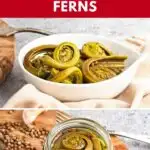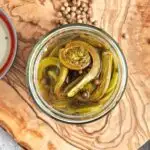If you've been foraging and are lucky enough to get your hands on some fiddlehead ferns, then you HAVE to try this pickled fiddleheads recipe! These fiddleheads have a tasty salty-tangy-sweet brine and can be water canned for storage or simply placed in the fridge for you to enjoy!

Jump to:
Fiddleheads recipe
The reason I love this pickled fiddleheads recipe is that you can preserve fiddleheads and enjoy them as a treat long after fiddlehead season is over! Fiddleheads have such a short and fleeting season, and I feel like sautéing them and eating them all in one meal is just not satisfying enough.
This is a great recipe if you only have a little bit of fiddleheads and want to make something special with them.
The brine is simple to make and has a great balance of vinegary, salty, and a little sweet. Make sure to keep reading below for ideas for how to serve fiddleheads and for what to do with leftover brine.
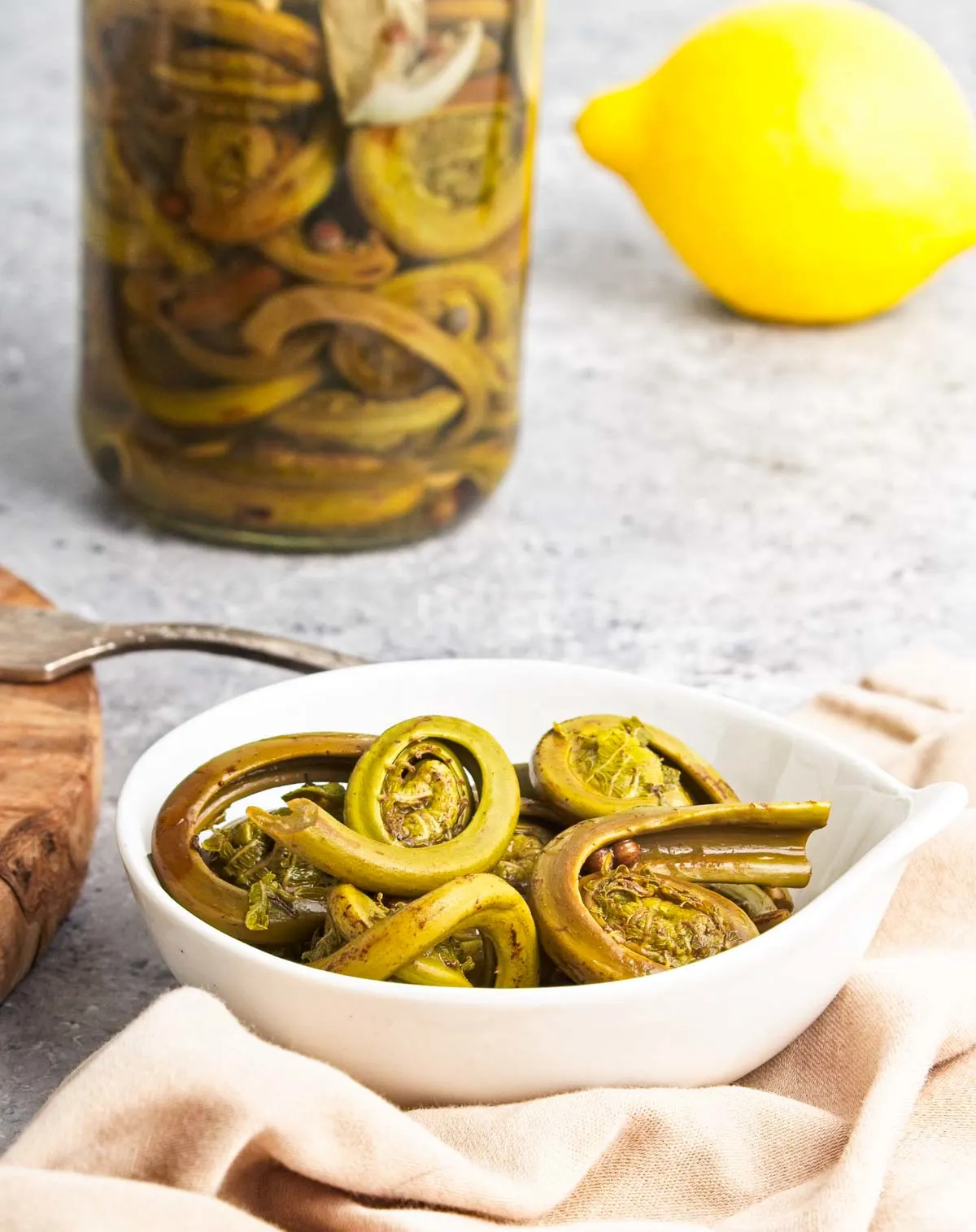
More foraging recipes to try: Garlic Mustard Pesto
Ingredients
- ½ - ¾ lb ostrich fern fiddleheads (enough to fill 2 8-oz pickling jars) - make sure you pick edible fiddleheads and are 100% confident in which fiddleheads you select. Consult with a local naturalist or purchase these from a trusted vendor at a farmer's market.
- ~4 cups water (for blanching the fiddleheads)
- 1 ¼ cup rice vinegar (or use apple cider vinegar)
- ¾ cup water (for the brine)
- 2 tablespoons granulated sugar (regular white sugar)
- 3 teaspoons salt, divided
- 2 cloves garlic, peeled and lightly crushed
- 1 teaspoon whole coriander seed
- ½ teaspoon rainbow or white peppercorns, lightly crushed (keep in mind that rainbow peppercorns can be a problem for people with nut allergies)
- 2 2-inch strips of lemon peel (try to get yellow zest only, minimal white pith. This can be done with a vegetable peeler)
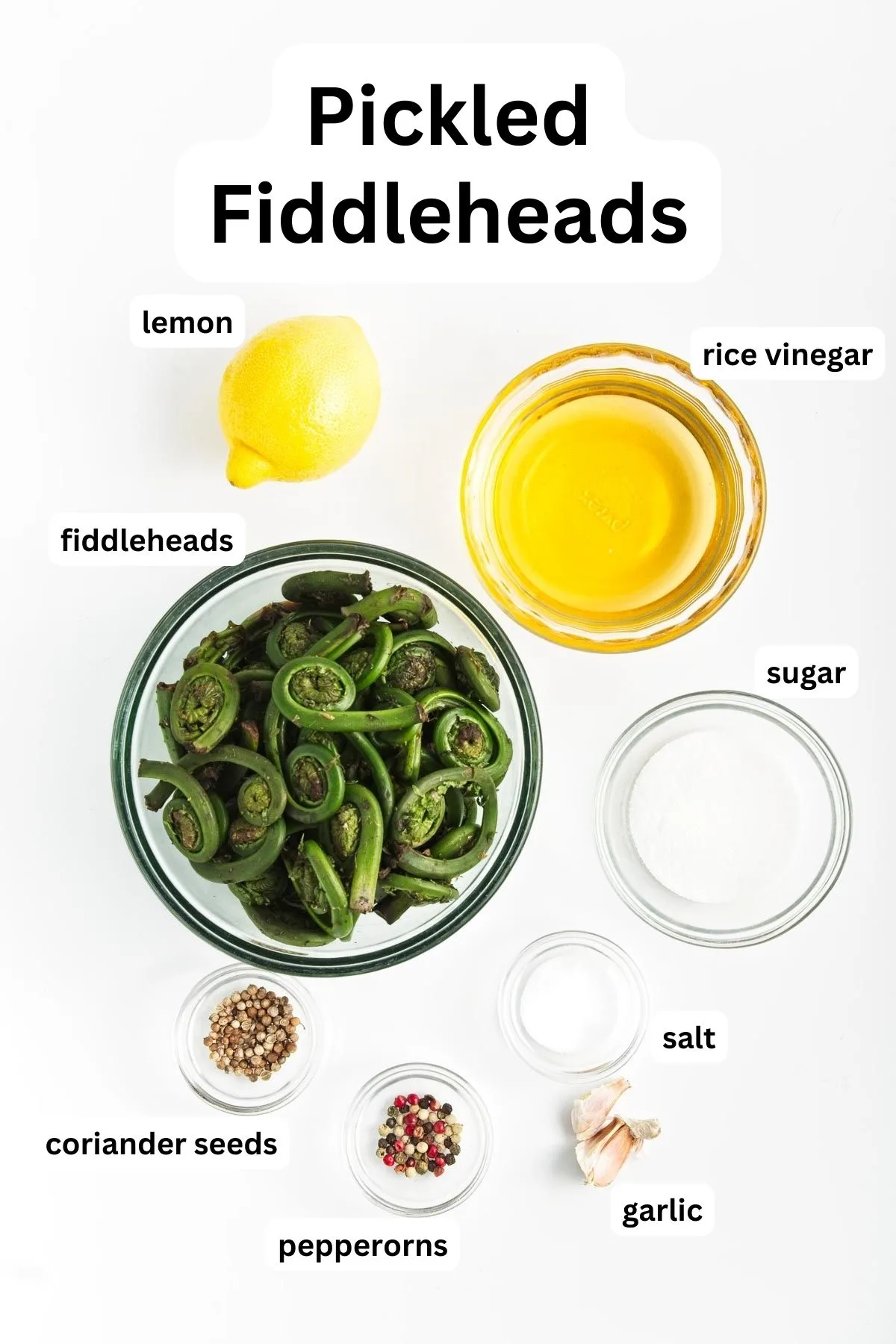
More foraging recipes to try: Mulberry Syrup
Equipment
- Measuring cups and spoons
- Medium saucepan/pot
- Large bowl with ice water
- 2 8-ounce jars with 2-part lids (or any glass jars, if not canning these)
- Vegetable peeler (for getting that strip of lemon peel)
- Optional: canning supplies
More canning recipes: Spicy Pepper Jelly
Instructions
Thoroughly wash fiddleheads in a large bowl of cool water, swirling to get all the loose dirt and papery coating off. Trim the ends off.
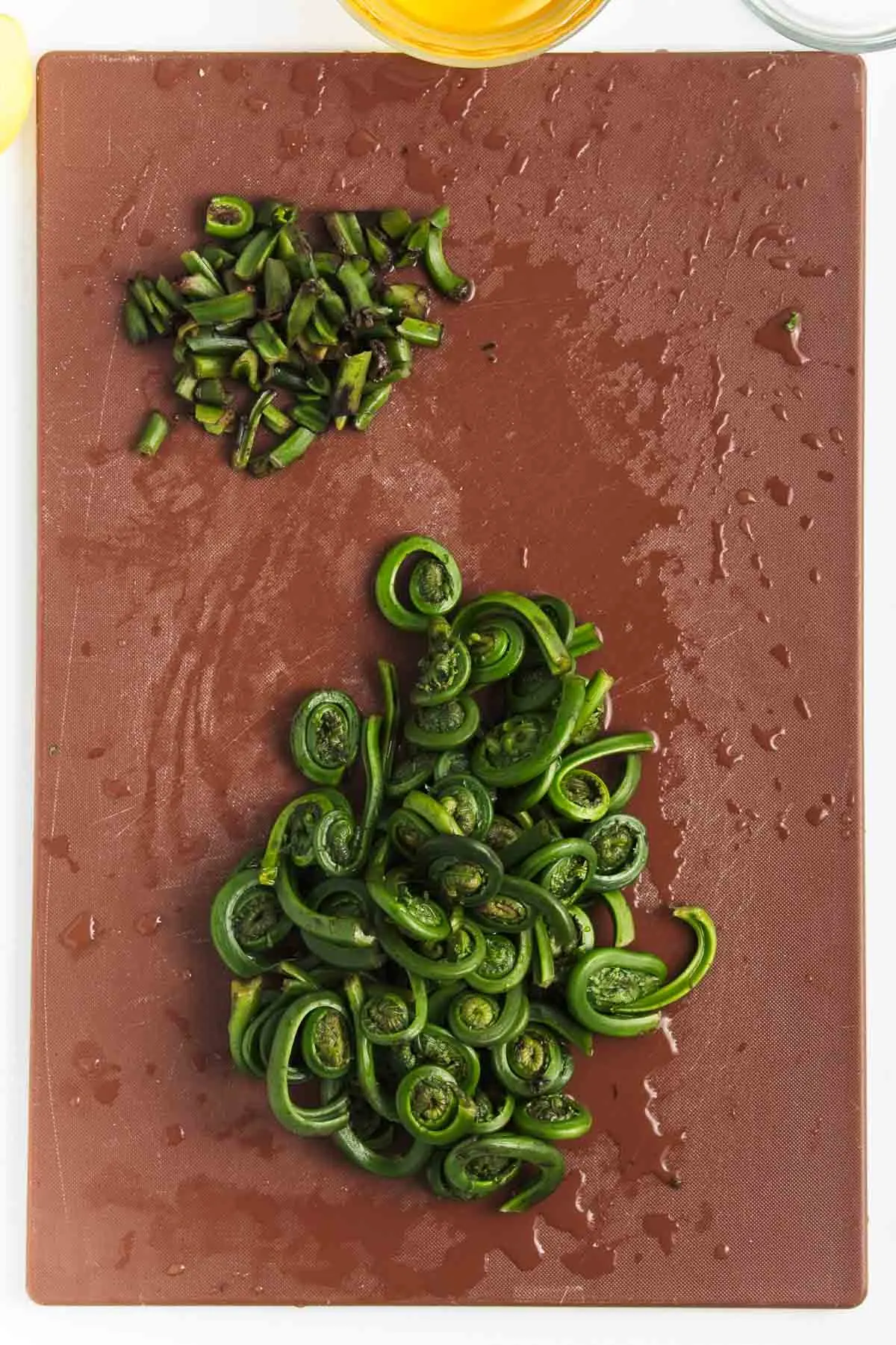
Get an ice bath ready.
Blanch the fiddleheads: In a medium saucepan or pot, add about 4 cups water with 1 teaspoon of the salt and bring to a boil. Add the cleaned fiddleheads and blanche for 60 seconds. Drain and rinse with ice water to stop the cooking.
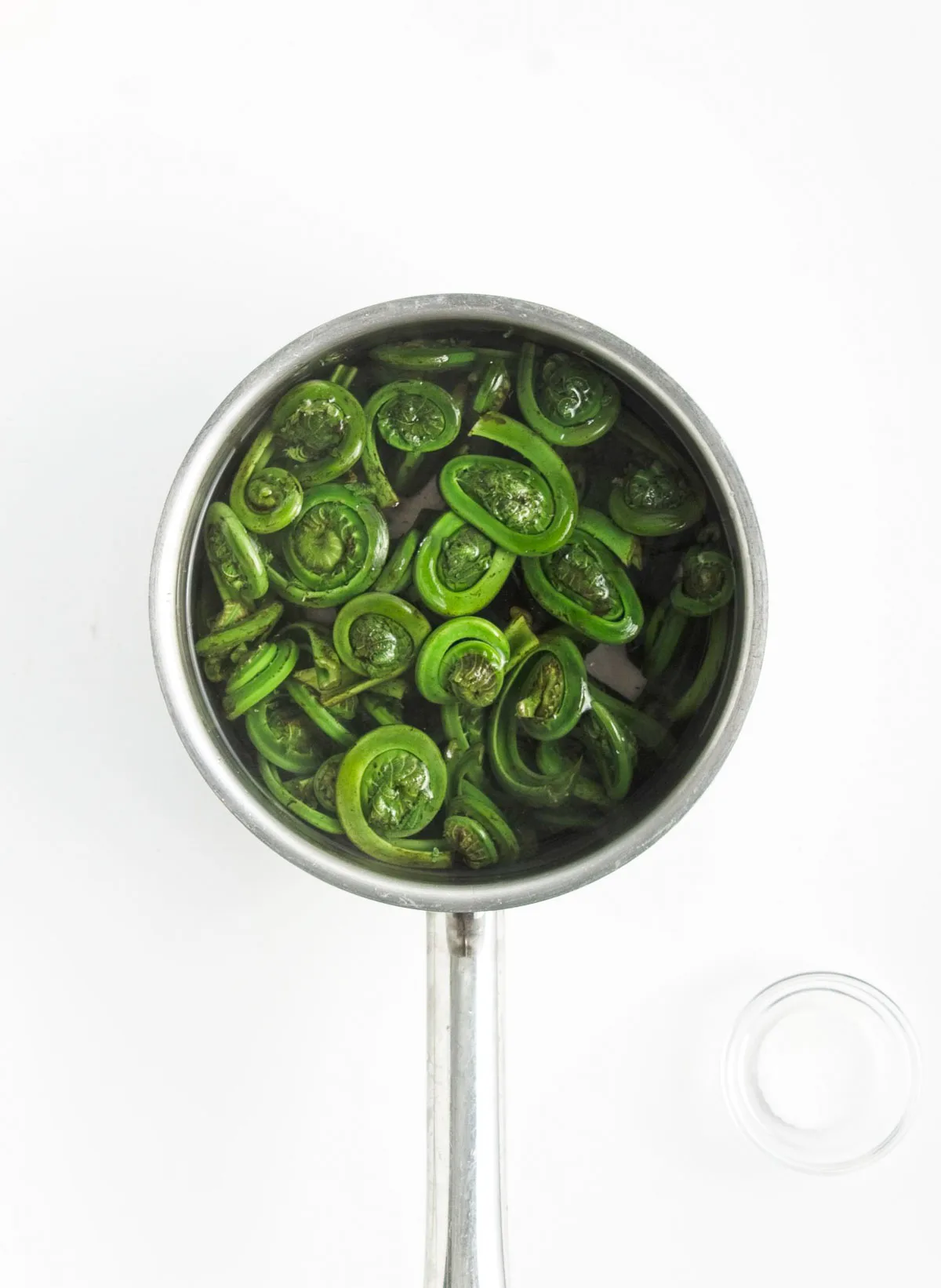
Place drained fiddleheads in 2 clean 8-ounce glass jars with tight sealing lids.
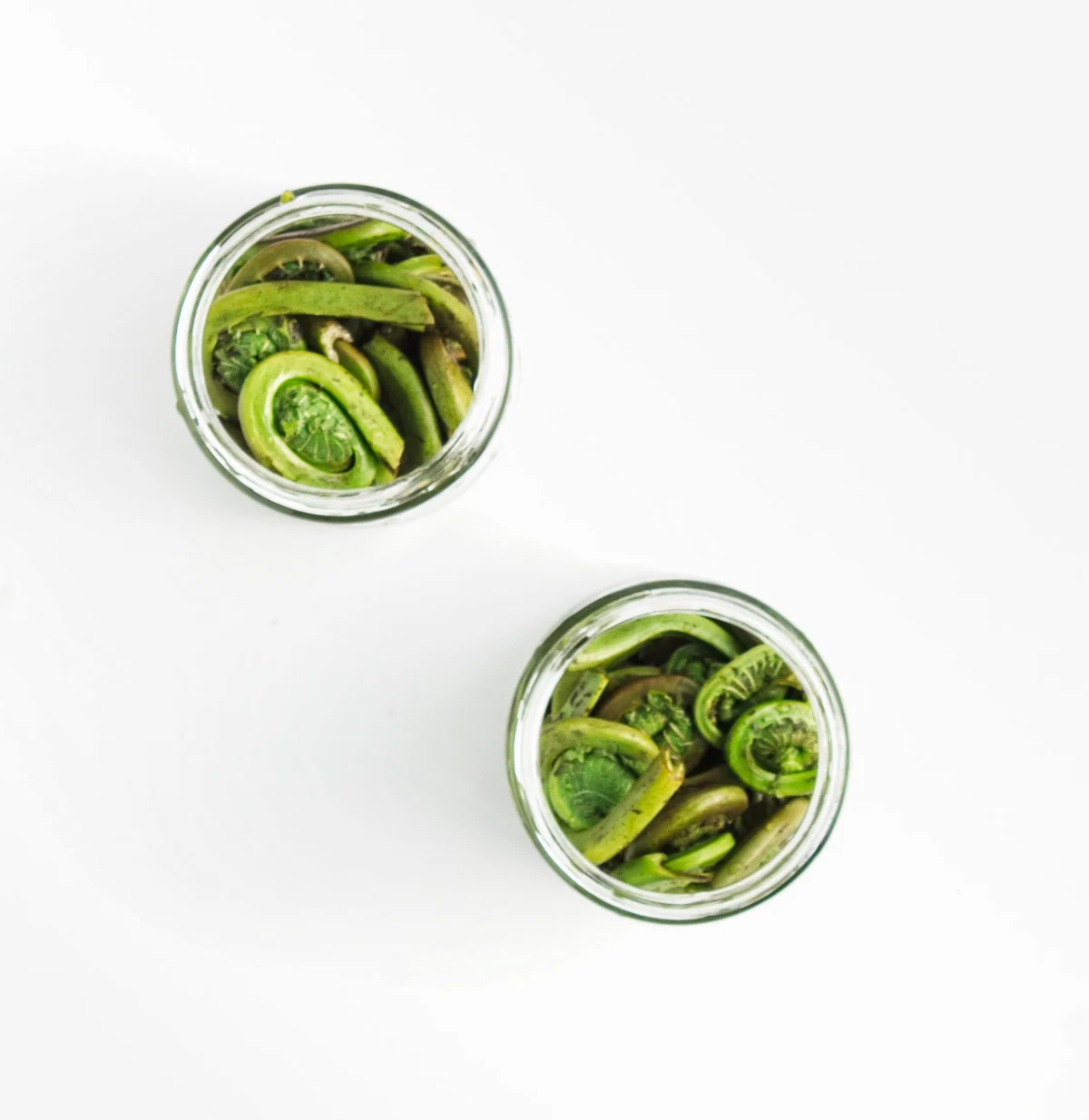
To each jar, add 1 clove crushed garlic and 1 strip of lemon peel. Divide the peppercorns and coriander seeds between the jars.
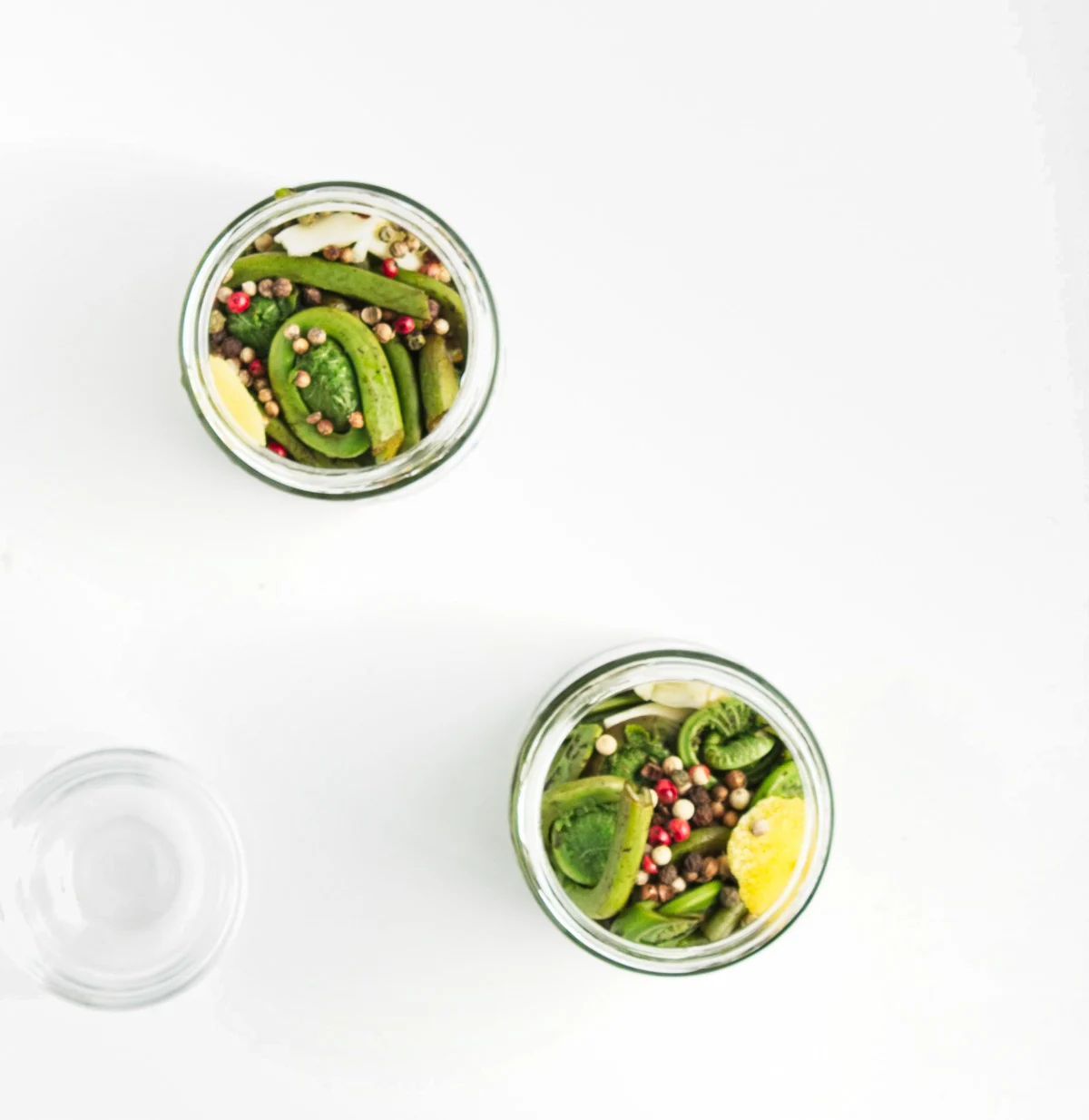
Make the brine: In a medium saucepan, combine the 1 ¼ cup vinegar, ¾ cup water, sugar, and 2 teaspoons salt. Bring to a simmer over medium heat, swirling until dissolved.
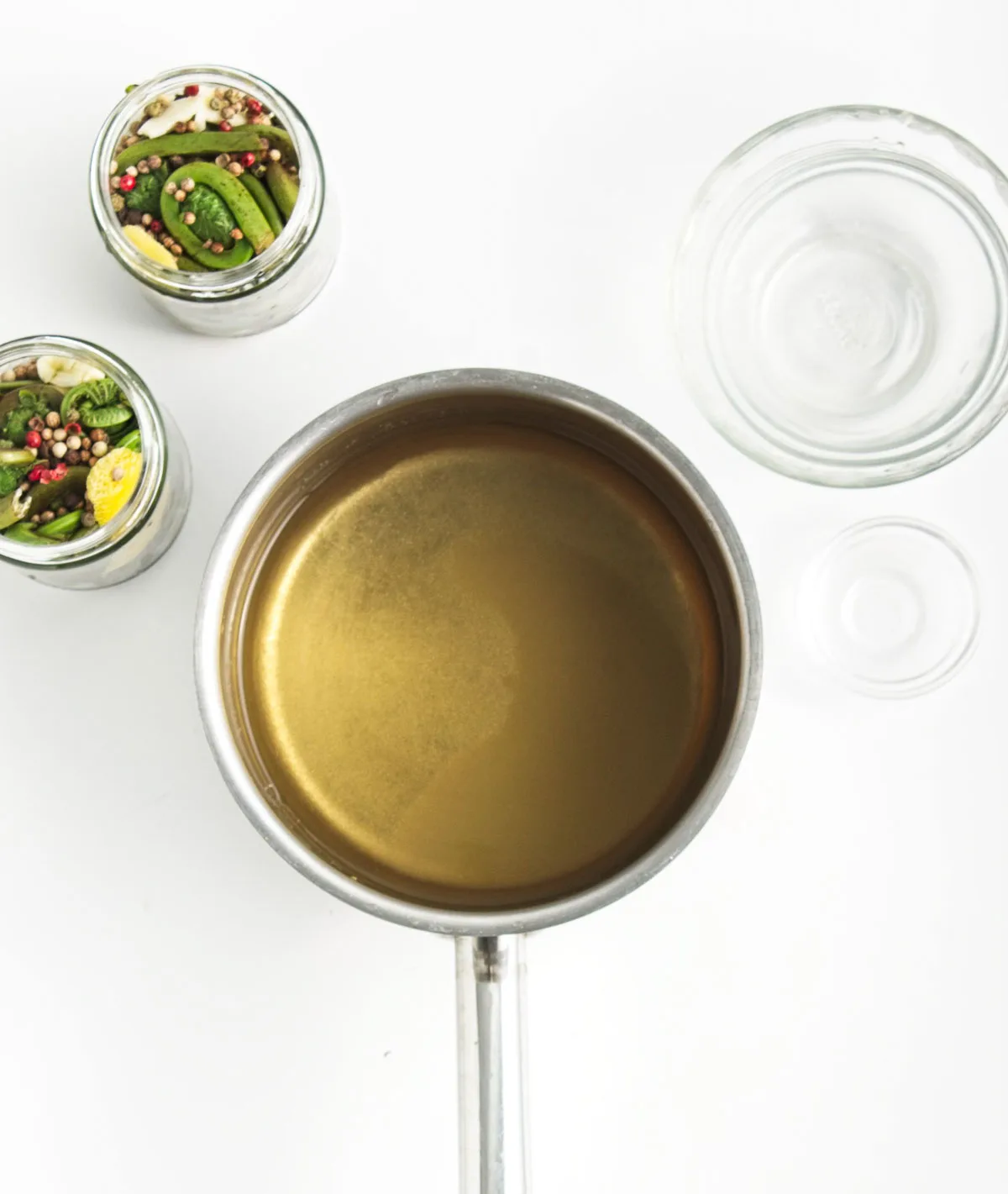
Pour the hot brine over the fiddleheads until just covered and there is ¼-inch space at the top of the jar. Carefully place lids (the jar is HOT!!) on and tighten.
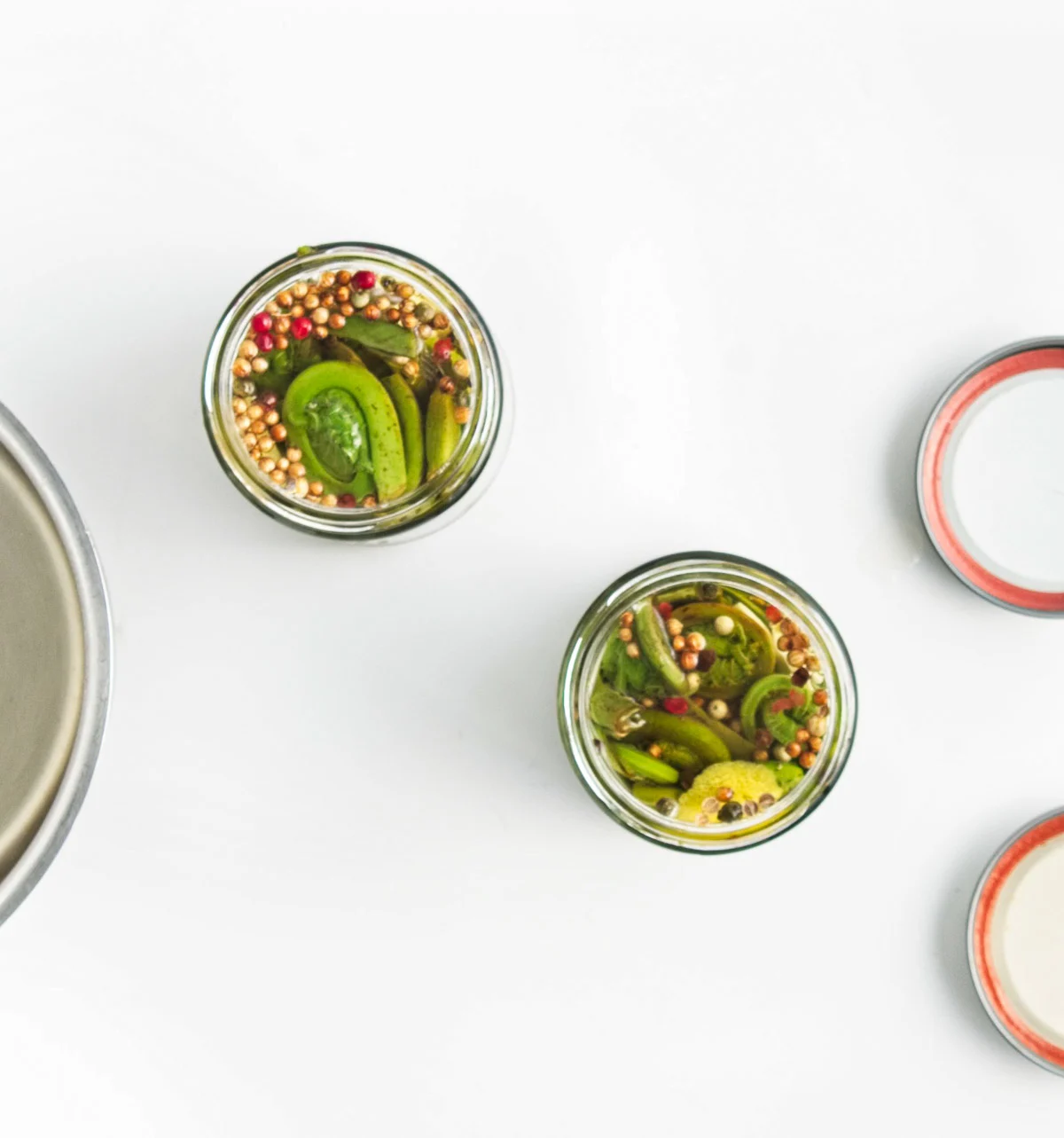
If planning to eat within a month, cool and refrigerate for up to 5 days to let the fiddleheads cure. Enjoy within a month.
If planning to store at room temperature, process in a water bath for 10 minutes.
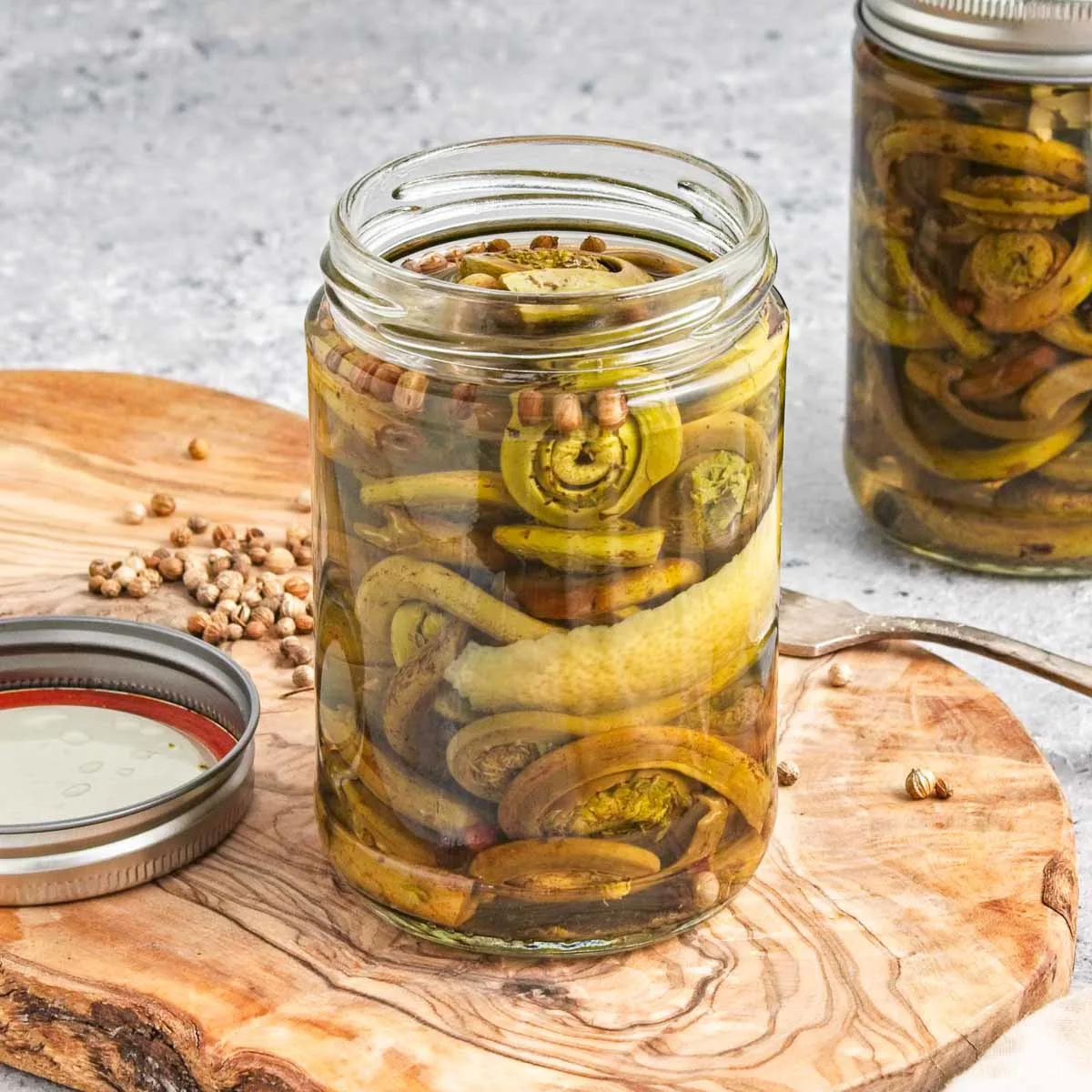
More spring recipes to try: Garlic Scape Butter
How to use pickled fiddleheads
- Add them to a charcuterie board
- Snack on them right from the jar
- Serve them along your main dish—the tangy flavor goes great with most proteins!
- Make ham & cream cheese rollups with pickled fiddleheads
- Deep fry them like fried pickles (the breading from this fried enoki mushroom recipe should work, just cut down on the salt)
- Add them to sandwiches (try them in my pickle grilled cheese)
More pickling recipes: Pickled Garlic Scapes
How to use leftover brine
- Marinate chicken in the brine
- Use it in place of vinegar in a vinaigrette dressing
- Drizzle some on salad with some olive oil in place of dressing
- Mix it with mayo to make a delicious tartar sauce-type of dip
Nothing goes to waste!!
What do fiddleheads taste like?
Fiddleheads taste like a combination of asparagus, broccoli, and green beans, once they are blanched. Raw fiddleheads will taste bitter, but you should not eat them raw. And of course, pickled fiddleheads will have more of a briny flavor with lots of tang, salty, and sweet flavors they take on from the brine that will be more dominant than their "green" flavor.
Why blanch fiddleheads?
Fiddleheads contain an enzyme that is harmful and need to be blanched or cooked before being eaten. The cooking process destroys the enzyme. Besides, fiddleheads taste bitter when raw! Just 1-2 minutes in boiling water is enough, and the fiddleheads will "cook" more in the hot brine as they cure.
If you enjoyed this recipe, let me know with a comment and a star rating below. And don't forget to share it on Facebook and save it on Pinterest for later!
Easy Pickled Fiddleheads
Ingredients
- ½ - ¾ lb asparagus - (enough to fill 2 8-oz pickling jars)
- approx 4 cups water - to blanch fiddleheads
- 3 teaspoons salt - divided
- 1 ¼ cup rice vinegar - (or use apple cider vinegar)
- ¾ cup water - (for the brine)
- 2 tablespoons granulated sugar
- 2 cloves garlic - peeled and lightly crushed
- 1 teaspoon whole coriander seed
- ½ teaspoon rainbow or white peppercorns - lightly crushed
- 2 2-inch strips of lemon peel - (try to get yellow zest only, minimal white pith)
Special equipment
- Bowl with ice water
- 2 8-ounce jars with 2-part lids (or any glass jars, if not canning these)
- Vegetable peeler (for getting that strip of lemon peel)
Instructions
- Thoroughly wash fiddleheads in a large bowl of cool water, swirling to get all the loose dirt and papery coating off. Trim the ends off.
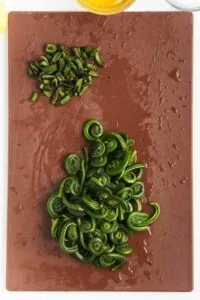
- Get an ice bath ready.
- Blanch the fiddleheads: In a medium saucepan or pot, add about 4 cups water with 1 teaspoon of the salt and bring to a boil. Add the cleaned fiddleheads and blanche for 60 seconds. Drain and rinse with ice water to stop the cooking.
- Place drained fiddleheads in 2 clean 8-ounce glass jars with tight sealing lids.
- To each jar, add 1 clove crushed garlic and 1 strip of lemon peel. Divide the peppercorns and coriander seeds between the jars.
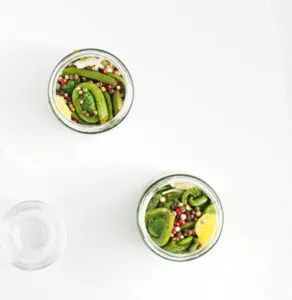
- Make the brine: In a medium saucepan, combine the 1¼ cup vinegar, ¾ cup water, 2 tablespoons sugar, and 2 teaspoons salt. Bring to a simmer over medium heat, swirling until dissolved.
- Pour the hot brine over the fiddleheads until just covered and there is ¼-inch space at the top of the jar. Carefully place lids (the jar is HOT!!) on and tighten.
- If planning to eat within a month, cool and refrigerate for up to 5 days to let the fiddleheads cure. Enjoy within a month.
- If planning to store at room temperature, process in a water bath for 10 minutes.
Notes
Nutrition
The nutritional information displayed is an estimate and not to be used as dietary or nutritional advice. Consult a nutritionist or dietician for nutritional info based on the exact ingredients you use.

